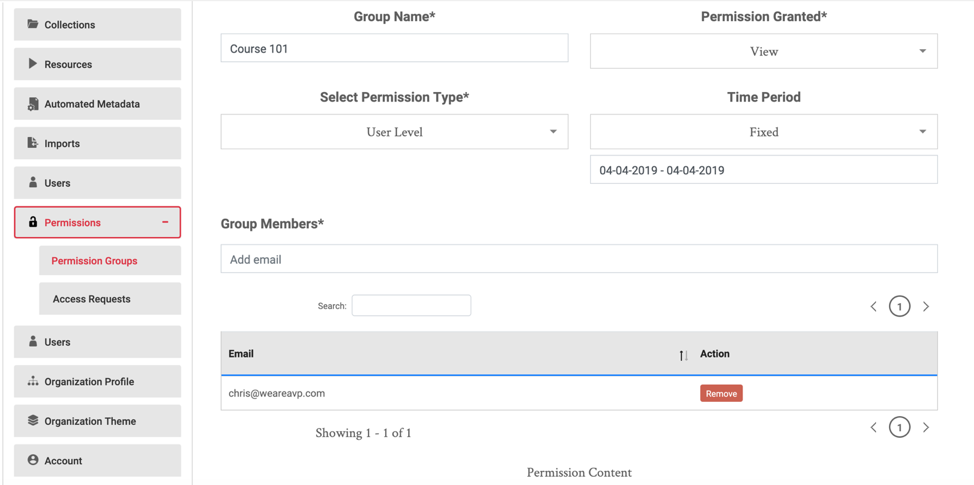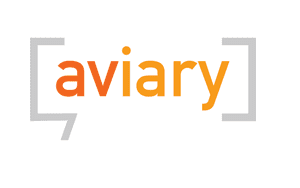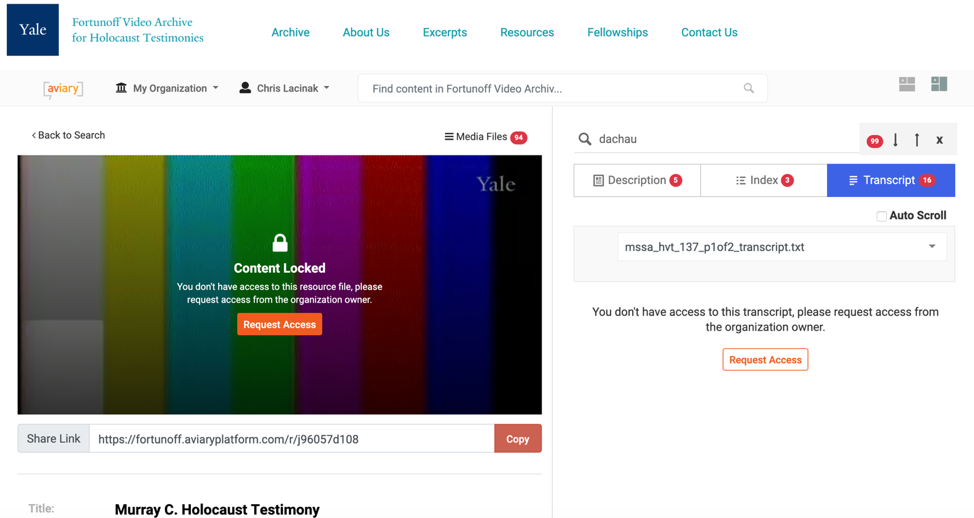Together AVP and FVA designed a new system to meet their joint objectives – a total package for FVA and any other organization with collections of audiovisual materials – one platform, by one developer, with one user interface, usable anywhere. Their collaboration is a model for archives worldwide – and indeed it is designed as a multi-tenant platform that can bring AV collections together. Why should other archives waste resources on developing their own discovery and access system that will only work with their archive, while they could be using those resources to enhance metadata, collect and catalog additional materials, or develop programing around their collections.
THE CHALLENGE
Making collection materials more openly discoverable and accessible to researchers is the core mission of many archives and libraries. This is also the mission of the Fortunoff Video Archive for Holocaust Testimonies (FVA), but the sensitive nature of its collection materials requires special considerations, for instance the need to maintain granular control over access permissions. Moreover, with a collection consisting of rich metadata like indexes, transcripts, catalog records and over 12,000 hours of video, the Archive needed to overcome serious obstacles inherent to searching AV collections. FVA was also intent on avoiding duplication of collection metadata in multiple silos. It needed a platform that would integrate with already existing databases of record. Finally, since the archive was embarking upon a complete website redesign, it wanted to provide users with a seamless experience when transitioning from website to collection search.
THE APPROACH
Partnering with AVP to create an AV discovery and streaming access platform specifically designed for archives and libraries. This platform provides:
1. Granular permissions and controlled access to allow content publishers to decide who gets to access their content, when, and under what conditions. There can be any number of reasons for controlling access to archive materials. For example, in FVA’s case:
- Many donors prohibit any commercial use of their material
- Some donors limit access to their material until an embargo has passed
- Some donors prohibit their material being shown in a particular country before a particular date (e.g. no viewing by any German IP address until 2025)
- Concerns for maintaining the privacy and protection of interviewees and their families
- There is a need to provide perpetual access to specific testimonies for survivors’ families
2. Most archives share this need to control access to honor donor agreements, comply with organizational policies, license agreements, and protect personal information, among other reasons. Regardless of the motivation, sophisticated access control is critical to responsible stewardship of archival material. In practice, this is often difficult to do effectively.
3. Search, navigation, and playback across audio and video archives, collections, and metadata, pinpointing search results with playback exactly where a search term is found.
4. A custom subdomain and total control over the design and look to create a seamless user experience.
“Many archives and libraries are struggling to develop their own audiovisual discovery and access systems incorporating sophisticated search, access control, intuitive playback and navigation. Since we couldn’t locate a system or suite of systems on the market that would meet our requirements, we partnered with AVP to create Aviary. For us it’s the total package for an AV archival collection – one hosted platform, supported by one developer, with one user interface, simple to use and available anywhere“.
– Stephen Naron, Director, the Fortunoff Video Archive for Holocaust Testimonies

Settling for Less: How Cobbling Together Disparate Systems Can Confound Users and Threaten Sustainability
The Fortunoff Video Archive for Holocaust Testimonies (FVA) traces its origins to 1979, when it began recording the testimonies of survivors, witnesses, and bystanders of the Holocaust thanks to the increasing availability of broadcast video technology. Stephen Naron, Director of FVA, explained “as in 1979, we continue to adopt new technology in pursuit of our core institutional goals – to record and make the voices of survivors available — to provide access to these invaluable historical sources for use in education and research”.
FVA is a small archive within a much larger institution. Its choice of video technology in the 1970s unintentionally resulted in many challenges to the preservation, distribution, and accessibility of the collection. Digitization was not an option, like so many AV archives, format obsolescence required it. As a wholly digital AV archive, FVA’s needs outpaced those of many other collections in its parent organization – a problem that will likely resonate with other AV archives. Still, determined to provide secure digital access, FVA wove together a discovery and access system from multiple enterprise platforms, all of which were controlled by other parties within a large institution. Users had to learn to use all the component systems each with different user interfaces. First, users searched in the library’s main catalog, then they requested access to individual testimonies in a second system. Once their request was approved, manually by FVA staff, users could view the video in a third system at specific partner locations. The three systems all had to be maintained and technically supported – a difficult and time-consuming task. This system also required complete manual administration of access control, which could result in disappointed researchers who had to wait for their request to be approved. Nevertheless, as complex as it was, this digital access system was an enormous leap forward. FVA partnered with about 40 locations worldwide to provide access to the collection, and testimony use grew by approximately 300% in a single year. With these results in hand, FVA knew it was on the right path. The next step was to provide its users with a more automated, simpler system.
Selecting a Partner to Create an Audiovisual Publishing Platform
For the FVA, taking this next step meant partnering with AVP, an established archival consulting and software development firm focused on freeing organizations from the obstacles of information management and maximizing the usability of data. AVP’s work has spanned academia, government and cultural heritage, museums, media and entertainment, performing arts, and not-for-profits. As Stephen Naron put it: “They’ve taught and worked in universities, archives, and libraries, they intuitively know the difference between informational vs. entertainment uses of video. We could not have had a more thoughtful partner for this effort. AVP’s understanding of the needs of the archival community and their commitment to improving the work that AV archives can do is incredible”.
A Better Experience for Archive Users, Researchers, and Administrators
The smarter path is to adopt ‘Aviary’ — an audiovisual publishing platform that makes AV content as intuitively searchable as text. In the case of FVA, researchers located at FVA partner locations worldwide can now easily search across the Archive’s more than 4,400 testimonies encompassing 12,000 hours of recorded materials in more than a dozen languages. Users can search through extensive metadata, thousands of detailed indexes, and transcripts of the testimonies in seconds.

Users only need a browser and internet access to search the archive. Registered users can even search basic metadata and obtain meaningful results for testimonies that require permission to access, providing FVA with the unprecedented ability to control access without sacrificing discoverability. Once found, users can request access, accept the terms of use, and can be granted viewing access by FVA. FVA partner locations are also granted access via an IP whitelist in order to provide easier viewing on-site at pre-approved locations. Aviary’s highly granular permissions support all FVA’s complex access control requirements, as well as many more that other organizations will need to support a diversity of use-cases.

Overall, does Aviary Meet your Objectives?
Stephen Naron summed it up: “Aviary helps us advance the goals of the Fortunoff Video Archive for Holocaust Testimonies by making it possible to search and navigate video testimony at a granular level, simplifying maintenance, and lowering our costs while increasing productivity. All of this has the end result ultimately of making the Archive and the stories it preserves more accessible for researchers and the families of survivors. Now that Aviary is online, we feel confident that we can scale up our outreach to additional partner locations worldwide, and expect exponential growth in the use of our archive”.